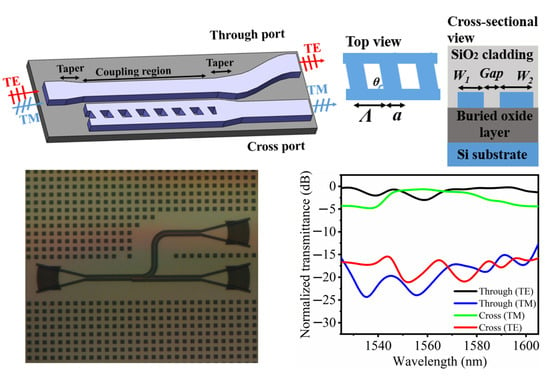Tilted Nano-Grating Based Ultra-Compact Broadband Polarizing Beam Splitter for Silicon Photonics
Abstract
:1. Introduction
2. Structure and Design
3. Fabrication and Characterization
4. Conclusions
Author Contributions
Funding
Conflicts of Interest
References
- Huang, J.; Yang, J.; Chen, D.; He, X.; Han, Y.; Zhang, J.; Zhang, Z. Ultra-compact broadband polarization beam splitter with strong expansibility. Photon- Res. 2018, 6, 574–578. [Google Scholar] [CrossRef]
- Liu, D.; Zhang, L.; Jiang, H.; Dai, D. First demonstration of an on-chip quadplexer for passive optical network systems. Photon. Res. 2021, 9, 757. [Google Scholar] [CrossRef]
- Richardson, D.; Fini, J.M.; Nelson, L.E. Space-division multiplexing in optical fibres. Nat. Photon. 2013, 7, 354–362. [Google Scholar] [CrossRef] [Green Version]
- Barwicz, T.; Watts, M.R.; Popovic, M.A.; Rakich, P.T.; Socci, L.; Kartner, F.X.; Ippen, E.P.; Smith, H.I. Polarization-transparent micro-photonic devices in the strong confinement limit. Nat. Photon. 2007, 1, 57–60. [Google Scholar] [CrossRef]
- Zhan, J.; Brock, J.; Veilleux, S.; Dagenais, M. Silicon nitride polarization beam splitter based on polarization-independent MMIs and apodized Bragg gratings. Opt. Express 2021, 29, 14476–14485. [Google Scholar] [CrossRef] [PubMed]
- Shen, B.; Wang, P.; Polson, R.C.; Menon, R. An integrated-nanophotonics polarization beam splitter with 2.4 × 2.4 µm2 footprint. Nat. Photon. 2015, 9, 378–382. [Google Scholar] [CrossRef]
- Wu, H.; Tan, Y.; Dai, D. Ultra-broadband high-performance polarizing beam splitter on silicon. Opt. Express 2017, 25, 6069–6075. [Google Scholar] [CrossRef] [PubMed]
- Lu, Z.; Yun, H.; Wang, Y.; Chen, Z.; Zhang, F.; Jaeger, N.A.F.; Chrostowski, L. Broadband silicon photonic directional coupler using asymmetric-waveguide based phase control. Opt. Express 2015, 23, 3795–3808. [Google Scholar] [CrossRef] [PubMed]
- Feng, J.; Akimoto, R. Silicon nitride polarizing beam splitter with potential application for intersubband-transition-based all-optical gate device. Jpn. J. Appl. Phys. 2015, 54, 04DG08. [Google Scholar] [CrossRef]
- Sun, X.; Alam, M.Z.; Aitchison, J.S.; Mojahedi, M. Compact and broadband polarization beam splitter based on a silicon nitride augmented low-index guiding structure. Opt. Lett. 2016, 41, 163–166. [Google Scholar] [CrossRef] [Green Version]
- Feng, J.; Akimoto, R. A Three-Dimensional Silicon Nitride Polarizing Beam Splitter. IEEE Photon. Technol. Lett. 2014, 26, 706–709. [Google Scholar] [CrossRef]
- Zhang, Y.; He, Y.; Wu, J.; Jiang, X.; Liu, R.; Qiu, C.; Jiang, X.; Yang, J.; Tremblay, C.; Su, Y. High-extinction-ratio silicon polarization beam splitter with tolerance to waveguide width and coupling length variations. Opt. Express 2016, 24, 6586–6593. [Google Scholar] [CrossRef]
- Guan, X.; Wu, H.; Shi, Y.; Dai, D. Extremely small polarization beam splitter based on a multimode interference coupler with a silicon hybrid plasmonic waveguide. Opt. Lett. 2014, 39, 259–262. [Google Scholar] [CrossRef] [PubMed]
- Feng, J.; Akimoto, R.; Zeng, H. Asymmetric Silicon Slot-Waveguide-Assisted Polarizing Beam Splitter. IEEE Photon Technol. Lett. 2016, 28, 1294–1297. [Google Scholar] [CrossRef]
- Zheng, W.; Xing, M.; Ren, G.; Johnson, S.G.; Zhou, W.; Chen, W.; Chen, L. Integration of a photonic crystal polarization beam splitter and waveguide bend. Opt. Express 2009, 17, 8657–8668. [Google Scholar] [CrossRef] [PubMed]
- Li, C.; Dai, D. Compact polarization beam splitter for silicon photonic integrated circuits with a 340-nm-thick silicon core layer. Opt. Lett. 2017, 42, 4243–4246. [Google Scholar] [CrossRef]
- Xu, L.; Wang, Y.; Kumar, A.; Patel, D.; El-Fiky, E.; Xing, Z.; Li, R.; Plant, D.V. Polarization Beam Splitter Based on MMI Coupler with SWG Birefringence Engineering on SOI. IEEE Photon. Technol. Lett. 2018, 30, 403–406. [Google Scholar] [CrossRef]
- Ni, B.; Xiao, J. Ultracompact and broadband silicon-based TE-pass 1 × 2 power splitter using subwavelength grating couplers and hybrid plasmonic gratings. Opt. Express 2018, 26, 33942–33955. [Google Scholar] [CrossRef]
- Mao, S.; Cheng, L.; Zhao, C.; Fu, H.Y. Ultra-broadband and ultra-compact polarization beam splitter based on a tapered subwavelength-grating waveguide and slot waveguide. Opt. Express 2021, 29, 28066–28077. [Google Scholar] [CrossRef]
- Qiu, H.; Su, Y.; Yu, P.; Hu, T.; Yang, J.; Jiang, X. Compact polarization splitter based on silicon grating-assisted couplers. Opt. Lett. 2015, 40, 1885–1887. [Google Scholar] [CrossRef]
- Luque-González, J.M.; Herrero-Bermello, A.; Ortega-Moñux, A.; Sánchez-Rodríguez, M.; Velasco, A.V.; Schmid, J.H.; Cheben, P.; Molina-Fernández, Í.; Halir, R. Polarization splitting directional coupler using tilted subwavelength gratings. Opt. Lett. 2020, 45, 3398–3401. [Google Scholar] [CrossRef]
- Gu, C.; Yeh, P. Form birefringence dispersion in periodic layered media. Opt. Lett. 1996, 21, 504–506. [Google Scholar] [CrossRef] [PubMed]
- Luque-Gonzalez, J.M.; Herrero-Bermello, A.; Ortega-Moñux, A.; Molina-Fernández, Í.; Velasco, A.V.; Cheben, P.; Schmid, J.H.; Wang, S.; Halir, R. Tilted subwavelength gratings: Controlling anisotropy in metamaterial nanophotonic waveguides. Opt. Lett. 2018, 43, 4691–4694. [Google Scholar] [CrossRef] [PubMed] [Green Version]
- Halir, R.; Bock, P.J.; Cheben, P.; Ortega-Moñux, A.; Alonso-Ramos, C.; Schmid, J.H.; Lapointe, J.; Xu, D.; Wangüemert-Pérez, J.G.; Molina-Fernández, Í.; et al. Waveguide sub-wavelength structures: A review of principles and applications. Laser Photon. Rev. 2015, 9, 25–49. [Google Scholar] [CrossRef]
- Halir, R.; Maese-Novo, A.; Ortega-Moñux, A.; Molina-Fernández, I.; Wangüemert-Pérez, J.G.; Cheben, P.; Xu, D.-X.; Schmid, J.H.; Janz, S. Colorless directional coupler with dispersion engineered sub-wavelength structure. Opt. Express 2012, 20, 13470–13477. [Google Scholar] [CrossRef] [PubMed] [Green Version]
- Chen, W.; Zhang, B.; Wang, P.; Dai, S.; Liang, W.; Li, H.; Fu, Q.; Li, J.; Li, Y.; Dai, T.; et al. Ultra-compact and low-loss silicon polarization beam splitter using a particle-swarm-optimized counter-tapered coupler. Opt. Express 2020, 28, 30701–30709. [Google Scholar] [CrossRef]
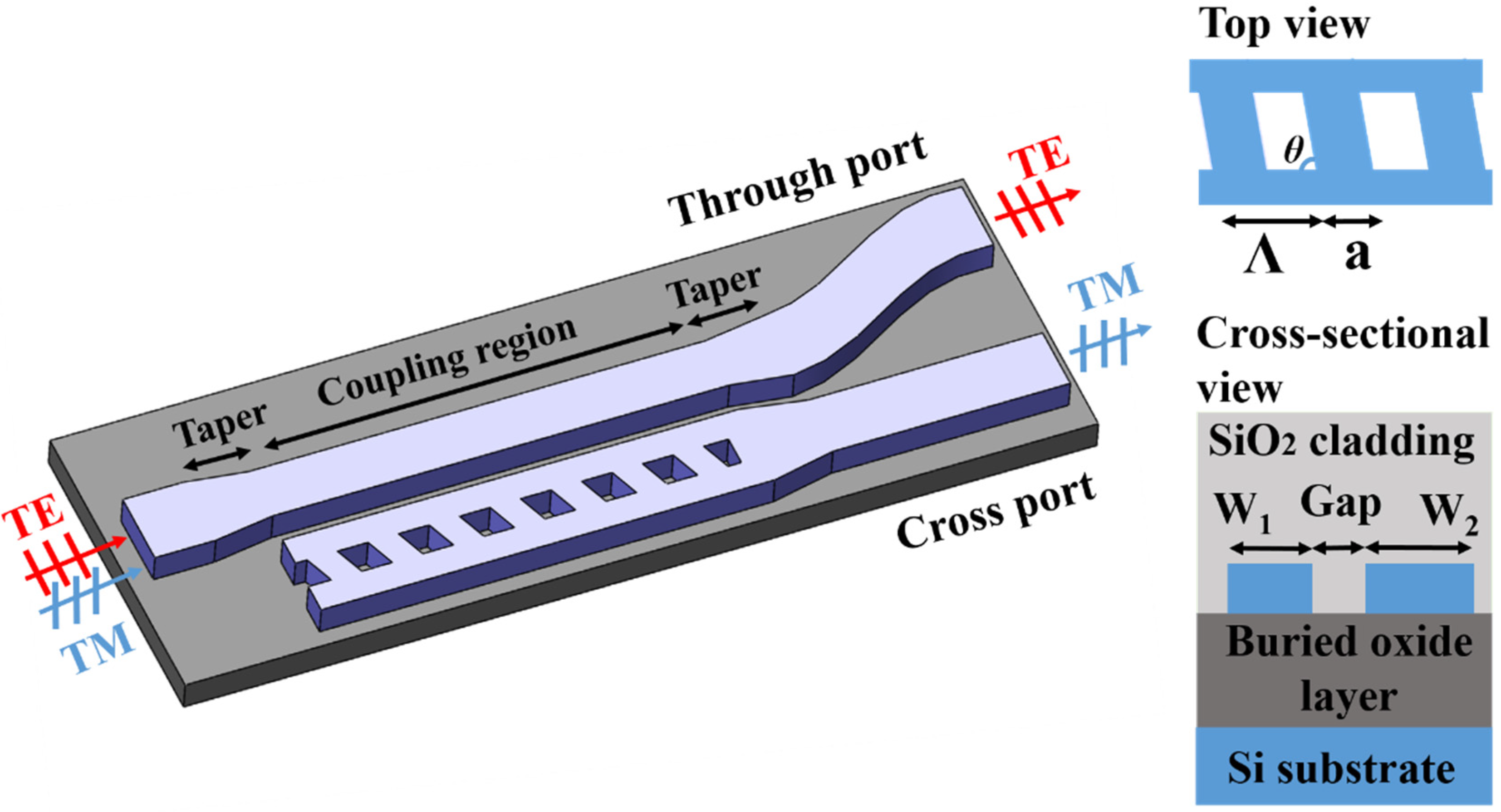


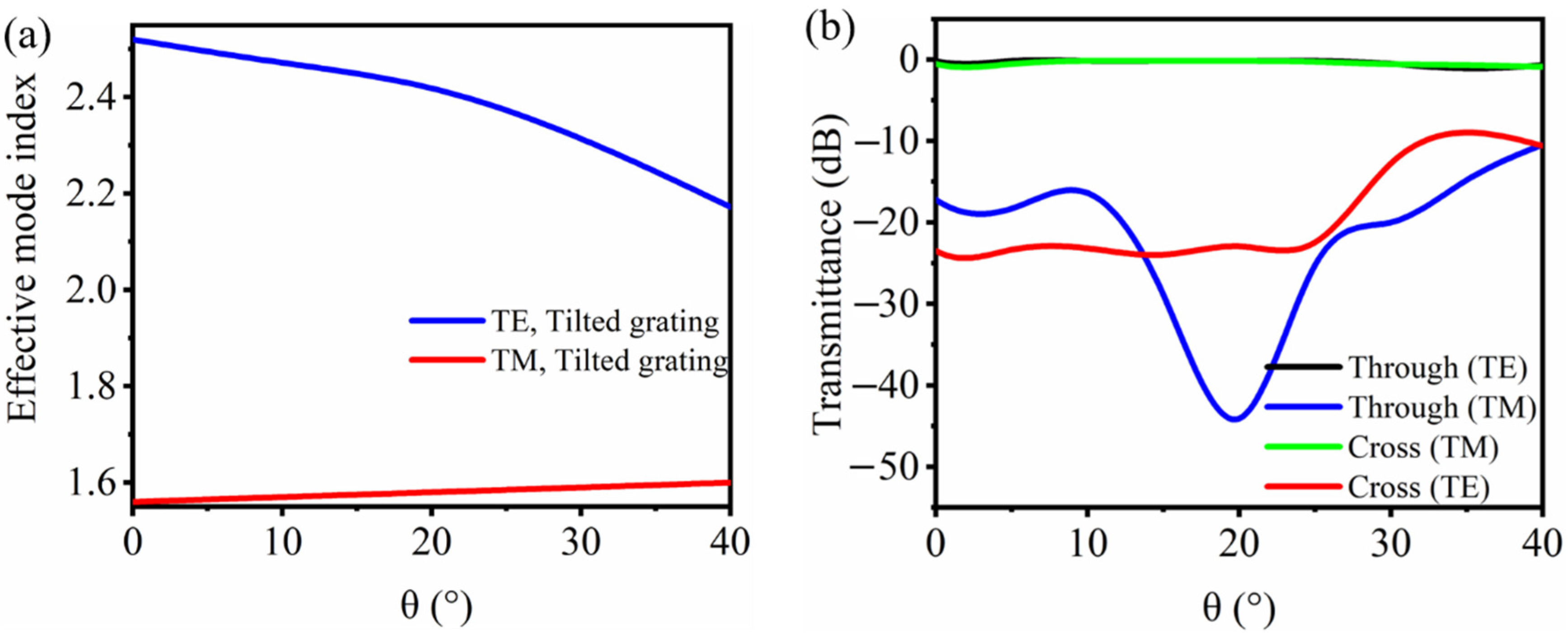

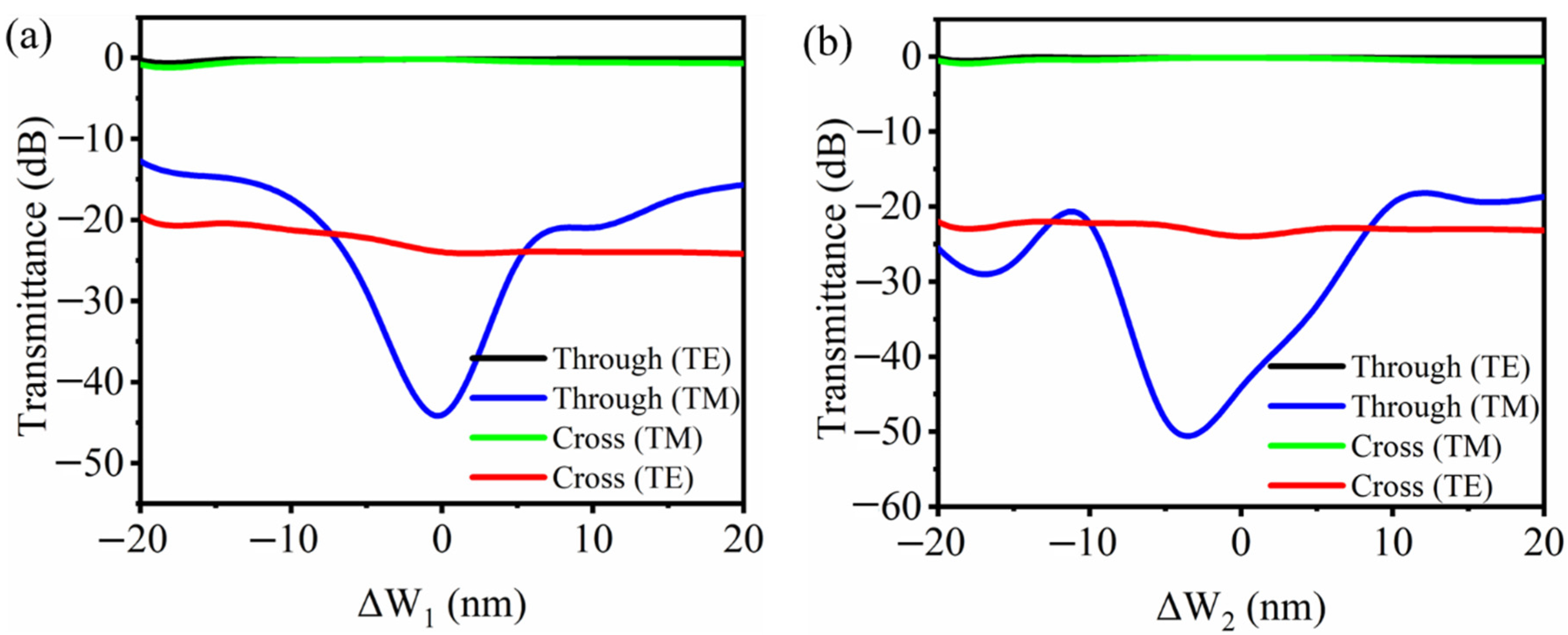
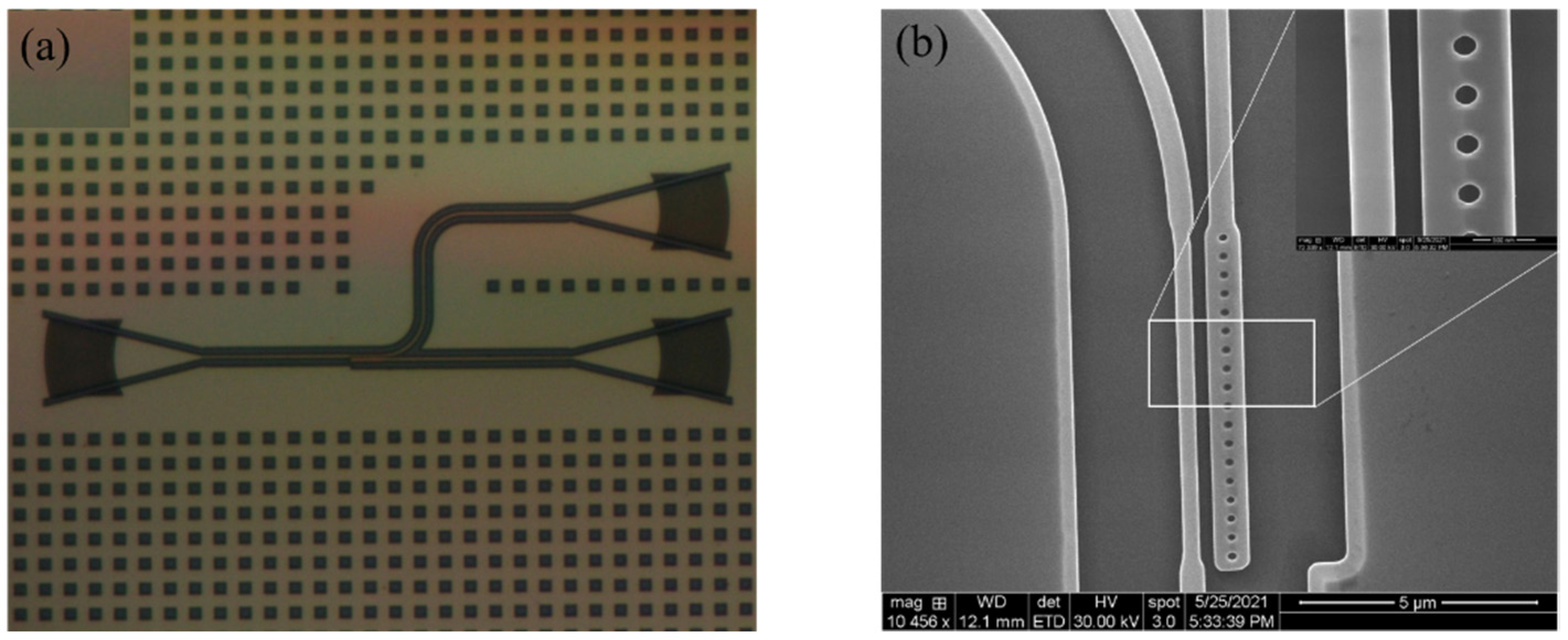
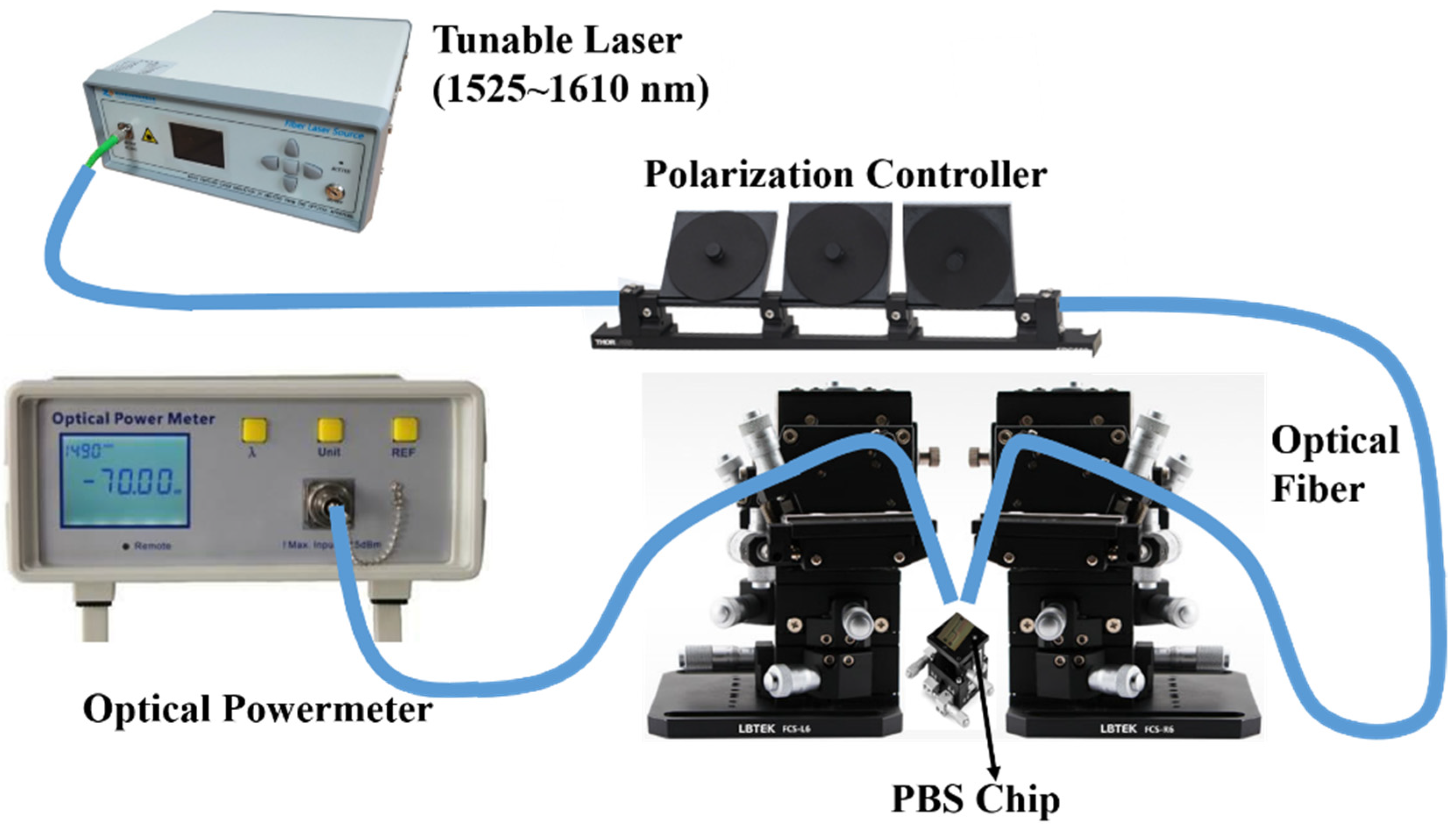


| Structures | Extinction Ratio | Insertion Loss | BW10 dB * | Length | Year |
|---|---|---|---|---|---|
| Grating assisted couplers [17] | 21 dB | 0.48 dB | 40 nm | 19 μm | 2015 |
| Asymmetric coupler with SWG [15] | 15 dB | 2.6 dB | 60 nm | 12 μm | 2017 |
| MMI coupler with SWG [16] | 20 dB | 2.5 dB | 84 nm | 100 µm | 2018 |
| Side-wall tilted SWG [18] | 15 dB | 1 dB | 72 nm | 14 μm | 2020 |
| This work | 23.76 dB | 0.2 dB | 80 nm | 6.8 μm |
Publisher’s Note: MDPI stays neutral with regard to jurisdictional claims in published maps and institutional affiliations. |
© 2021 by the authors. Licensee MDPI, Basel, Switzerland. This article is an open access article distributed under the terms and conditions of the Creative Commons Attribution (CC BY) license (https://creativecommons.org/licenses/by/4.0/).
Share and Cite
Liu, H.; Feng, J.; Ge, J.; Zhuang, S.; Yuan, S.; Chen, Y.; Li, X.; Tan, Q.; Yu, Q.; Zeng, H. Tilted Nano-Grating Based Ultra-Compact Broadband Polarizing Beam Splitter for Silicon Photonics. Nanomaterials 2021, 11, 2645. https://doi.org/10.3390/nano11102645
Liu H, Feng J, Ge J, Zhuang S, Yuan S, Chen Y, Li X, Tan Q, Yu Q, Zeng H. Tilted Nano-Grating Based Ultra-Compact Broadband Polarizing Beam Splitter for Silicon Photonics. Nanomaterials. 2021; 11(10):2645. https://doi.org/10.3390/nano11102645
Chicago/Turabian StyleLiu, Haipeng, Jijun Feng, Jinman Ge, Shanqing Zhuang, Shuo Yuan, Yishu Chen, Xiaojun Li, Qinggui Tan, Qinghua Yu, and Heping Zeng. 2021. "Tilted Nano-Grating Based Ultra-Compact Broadband Polarizing Beam Splitter for Silicon Photonics" Nanomaterials 11, no. 10: 2645. https://doi.org/10.3390/nano11102645
APA StyleLiu, H., Feng, J., Ge, J., Zhuang, S., Yuan, S., Chen, Y., Li, X., Tan, Q., Yu, Q., & Zeng, H. (2021). Tilted Nano-Grating Based Ultra-Compact Broadband Polarizing Beam Splitter for Silicon Photonics. Nanomaterials, 11(10), 2645. https://doi.org/10.3390/nano11102645








